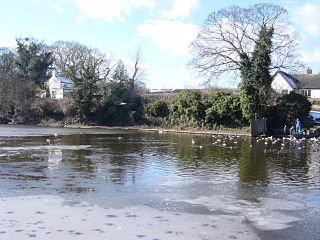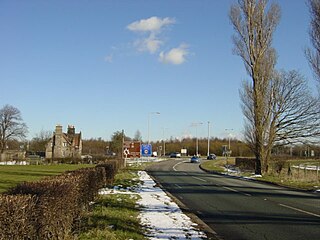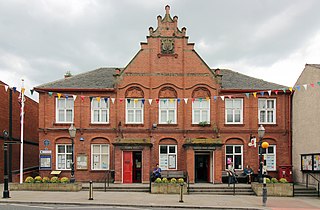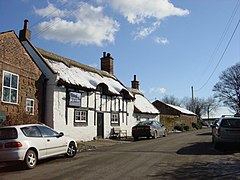
Bebington is a town in the Metropolitan Borough of Wirral, in Merseyside, England. Historically part of Cheshire, it is 5 miles (8 km) south of Liverpool, close to the River Mersey on the eastern side of the Wirral Peninsula. Nearby towns include Birkenhead and Wallasey to the north-northwest, and Heswall to the west-southwest. Bebington railway station opened in 1838 and is on the Wirral line of the Merseyrail network.

Bromborough is a town in the Metropolitan Borough of Wirral, Merseyside, England, and the historic county of Cheshire, on the Wirral Peninsula southeast of Bebington and north of Eastham.

Tranmere is a suburb of Birkenhead, on the Wirral Peninsula, England. Administratively, it is within the Birkenhead and Tranmere Ward of the Metropolitan Borough of Wirral, in Merseyside. Before local government reorganisation on 1 April 1974, it was part of the County Borough of Birkenhead, within the county of Cheshire.
The Hundred of Wirral is the ancient administrative area for the Wirral Peninsula. Its name is believed to have originated from the Hundred of Wilaveston, the historic name for Willaston, which was an important assembly point in the Wirral Hundred during the Middle Ages. The ton suffix in a place name normally indicates a previous use as a meeting location for officials. During its existence, the hundred was one of the Hundreds of Cheshire.

The Wirral Peninsula, known locally as the Wirral, is a peninsula in North West England. The roughly rectangular peninsula is about 15 miles (24 km) long and 7 miles (11 km) wide, and is bounded by the Dee Estuary to the west, the Mersey Estuary to the east, and Liverpool Bay to the north.

Prenton is a suburb of Birkenhead, Merseyside, England. Administratively, it is also a ward of the Metropolitan Borough of Wirral. Before local government reorganisation on 1 April 1974, it was part of the County Borough of Birkenhead, within the county of Cheshire. Situated in the east of the Wirral Peninsula, the area is contiguous with Oxton to the north, Tranmere and Rock Ferry to the east and Higher Bebington to the south east. The M53 motorway marks the western boundary.

Spital is a village in the Metropolitan Borough of Wirral, in Merseyside, England. It is located mid-way on the Wirral Peninsula, and is mostly incorporated into the town of Bebington and the most westerly point of Spital forms the most northern edge of Bromborough.

Thornton Hough is a village in the Wirral district of Merseyside, England. The village lies in the more rural inland part of the Wirral Peninsula and is of pre-Norman Conquest origins. The village grew during the ownership of Joseph Hirst into a small model village and was later acquired by William Lever, founder of Lever Brothers, the predecessor of Unilever. Thornton Hough is roughly 10 miles (16 km) from Liverpool and 12 miles (19 km) from Chester. It is part of the Clatterbridge ward and is in the parliamentary constituency of Wirral South.

Noctorum is a suburb of Birkenhead, Merseyside, England. Administratively it is within the Metropolitan Borough of Wirral as part of Claughton Ward. Noctorum is in the north east of the Wirral Peninsula, bounded by the Beechwood estate to the north, Claughton and Oxton to the east and south east, and the River Fender and M53 motorway to the west.

Wirral was a county constituency which returned one Member of Parliament (MP) to the House of Commons of the Parliament of the United Kingdom from 1885 to 1983, elected by the first past the post voting system.

Brimstage is a village and former civil parish in the Wirral district, in the county of Merseyside, England. It is in the centremost part of the Wirral Peninsula, approximately 3 miles (4.8 km) east of Heswall and 3 miles (4.8 km) south west of Bebington. Administratively, it is within the Clatterbridge Ward and is in the parliamentary constituency of Wirral South.

Larton is a hamlet near the town of West Kirby, on the Wirral Peninsula, in Merseyside, England. Administratively it is part of the local government ward of Greasby, Frankby and Irby in the Metropolitan Borough of Wirral and is within the parliamentary constituency of Wirral West.

Storeton is a small village and former civil parish in the Wirral district, in the county of Merseyside, England, on the Wirral Peninsula. It is west of the town of Bebington and is made up of Great Storeton and Little Storeton, which is classified as a hamlet. At the 2001 Census the population of Storeton was recorded as 150.

Gayton is a village in the Wirral district, in Merseyside, England, located between Heswall and Parkgate. At the 2001 Census, the population of Gayton stood at 3,110.

Raby Mere is a hamlet on the Wirral Peninsula, England. Adjacent to the Green Belt, woodland and open countryside, it is known for its mere, a lake that has been used for leisure purposes for many years. The hamlet of Raby is located two miles west.

Clatterbridge is a hamlet on the Wirral Peninsula, in the Metropolitan Borough of Wirral, Merseyside, England. It is to the south-west of Bebington and close to the M53 motorway. Clatterbridge is also the name of a local government ward, which includes Brimstage, Raby, Raby Mere, Thornton Hough, Storeton, Spital and the western fringes of Bromborough and Eastham.

Bebington was a local government district on the Wirral Peninsula, in Cheshire, England.

Neston Urban District was an urban district in Cheshire, England and previously known as Neston and Parkgate Urban District (1894-1933). It was the local authority for Neston and Parkgate, in the south-west of the Wirral Peninsula.
The ceremonial county of Cheshire, which comprises the unitary authorities of Cheshire East, Cheshire West and Chester, Halton and Warrington, returned 11 MPs to the UK Parliament from 1997 to 2024. Under the 2023 review of Westminster constituencies, coming into effect for the 2024 general election, the boundary commission proposed 12 constituencies, including two which crossed the border into the county of Merseyside.


















